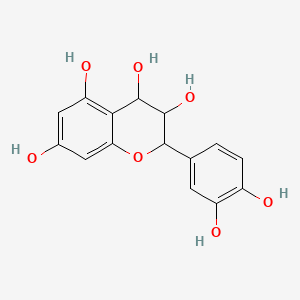| MeSH term | MeSH ID | Detail |
|---|---|---|
| Gastritis | D005756 | 27 associated lipids |
| Byssinosis | D002095 | 11 associated lipids |
Leucocyanidin
Leucocyanidin is a lipid of Polyketides (PK) class. Leucocyanidin is associated with abnormalities such as Dehydration. The involved functions are known as Pigment, enzyme activity, proanthocyanidin biosynthetic process, Sterility and Signal. Leucocyanidin often locates in Body tissue, Autonomic nervous system, Cytosol, Vacuole and insoluble fraction. The associated genes with Leucocyanidin are F3 gene and Orthologous Gene. The related lipids are Butanols.
Cross Reference
Introduction
To understand associated biological information of Leucocyanidin, we collected biological information of abnormalities, associated pathways, cellular/molecular locations, biological functions, related genes/proteins, lipids and common seen animal/experimental models with organized paragraphs from literatures.
What diseases are associated with Leucocyanidin?
Leucocyanidin is suspected in Dehydration and other diseases in descending order of the highest number of associated sentences.
Related references are mostly published in these journals:
| Disease | Cross reference | Weighted score | Related literature |
|---|
Possible diseases from mapped MeSH terms on references
We collected disease MeSH terms mapped to the references associated with Leucocyanidin
PubChem Associated disorders and diseases
What pathways are associated with Leucocyanidin
There are no associated biomedical information in the current reference collection.
PubChem Biomolecular Interactions and Pathways
Link to PubChem Biomolecular Interactions and PathwaysWhat cellular locations are associated with Leucocyanidin?
Visualization in cellular structure
Associated locations are in red color. Not associated locations are in black.
Related references are published most in these journals:
| Location | Cross reference | Weighted score | Related literatures |
|---|
What functions are associated with Leucocyanidin?
Related references are published most in these journals:
| Function | Cross reference | Weighted score | Related literatures |
|---|
What lipids are associated with Leucocyanidin?
Related references are published most in these journals:
| Lipid concept | Cross reference | Weighted score | Related literatures |
|---|
What genes are associated with Leucocyanidin?
Related references are published most in these journals:
| Gene | Cross reference | Weighted score | Related literatures |
|---|
What common seen animal models are associated with Leucocyanidin?
There are no associated biomedical information in the current reference collection.
NCBI Entrez Crosslinks
All references with Leucocyanidin
Download all related citations| Authors | Title | Published | Journal | PubMed Link |
|---|---|---|---|---|
| Lewis DA et al. | A natural flavonoid present in unripe plantain banana pulp (Musa sapientum L. var. paradisiaca) protects the gastric mucosa from aspirin-induced erosions. | 1999 | J Ethnopharmacol | pmid:10404428 |
| Aizza LC and Dornelas MC | A genomic approach to study anthocyanin synthesis and flower pigmentation in passionflowers. | 2011 | J Nucleic Acids | pmid:21772993 |
| Buchalter L | Identification of polymeric 5,7,3',4'-tetrahydroxyflavan-3,4-diol from tannin extract of powdered cassia bark, Saigon, cinnamon USP, Cinnamomum loureirii Nees, family Lauraceae. | 1971 | J Pharm Sci | pmid:5548229 |
| Zhang JR et al. | Production of 3,4-cis- and 3,4-trans-Leucocyanidin and Their Distinct MS/MS Fragmentation Patterns. | 2018 | J. Agric. Food Chem. | pmid:29231723 |
| Nakajima J et al. | Reaction mechanism from leucoanthocyanidin to anthocyanidin 3-glucoside, a key reaction for coloring in anthocyanin biosynthesis. | 2001 | J. Biol. Chem. | pmid:11316805 |
| Yang J et al. | Identification of rutin deglycosylated metabolites produced by human intestinal bacteria using UPLC-Q-TOF/MS. | 2012 | J. Chromatogr. B Analyt. Technol. Biomed. Life Sci. | pmid:22583754 |
| Ayars GH et al. | Cotton dust-mediated lung epithelial injury. | 1986 | J. Clin. Invest. | pmid:3782472 |
| Yuan L et al. | Molecular cloning and characterization of PtrLAR3, a gene encoding leucoanthocyanidin reductase from Populus trichocarpa, and its constitutive expression enhances fungal resistance in transgenic plants. | 2012 | J. Exp. Bot. | pmid:22268151 |
| Khan SA et al. | Genetic analysis of metabolites in apple fruits indicates an mQTL hotspot for phenolic compounds on linkage group 16. | 2012 | J. Exp. Bot. | pmid:22330898 |
| Han Y et al. | Introduction of apple ANR genes into tobacco inhibits expression of both CHI and DFR genes in flowers, leading to loss of anthocyanin. | 2012 | J. Exp. Bot. | pmid:22238451 |
